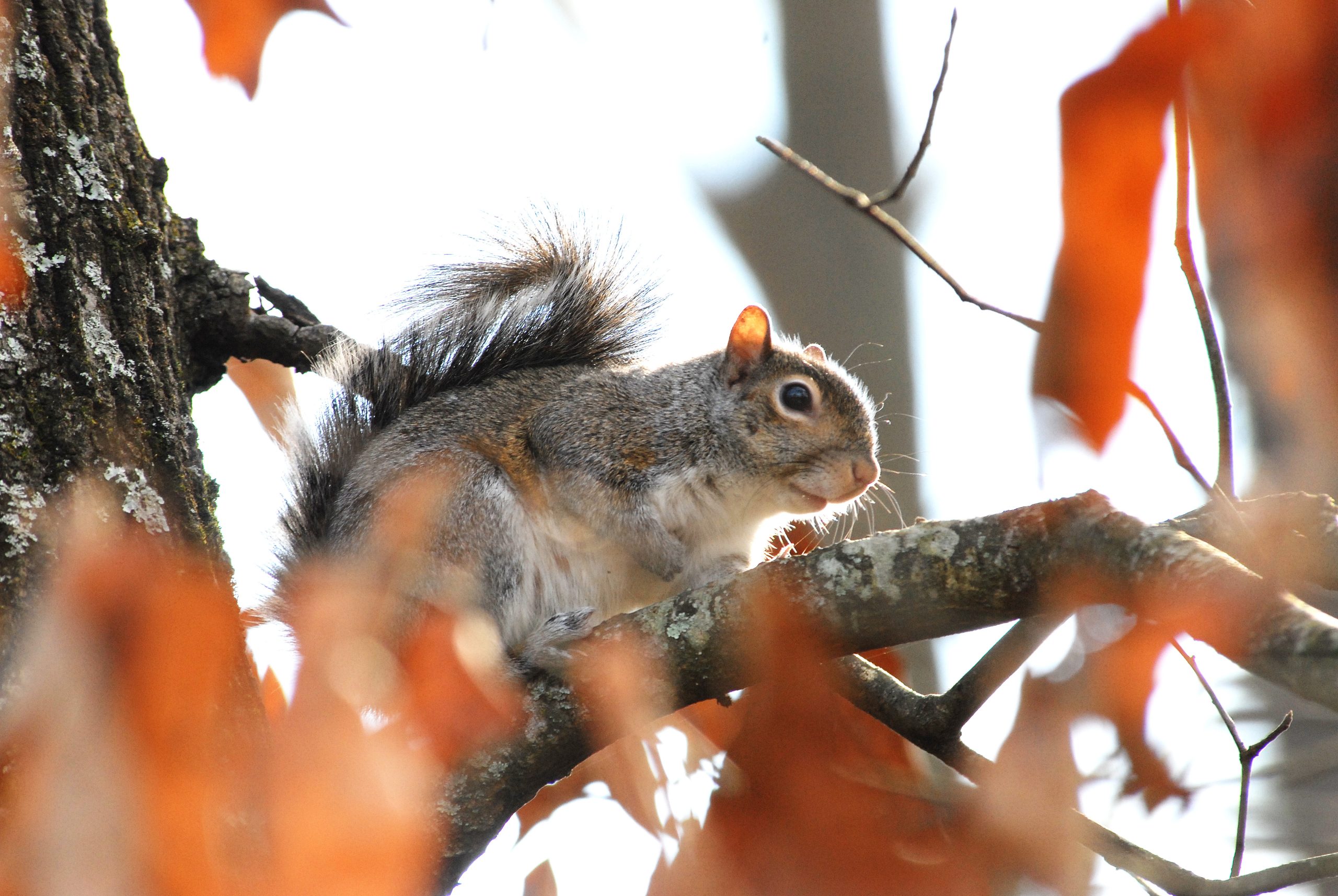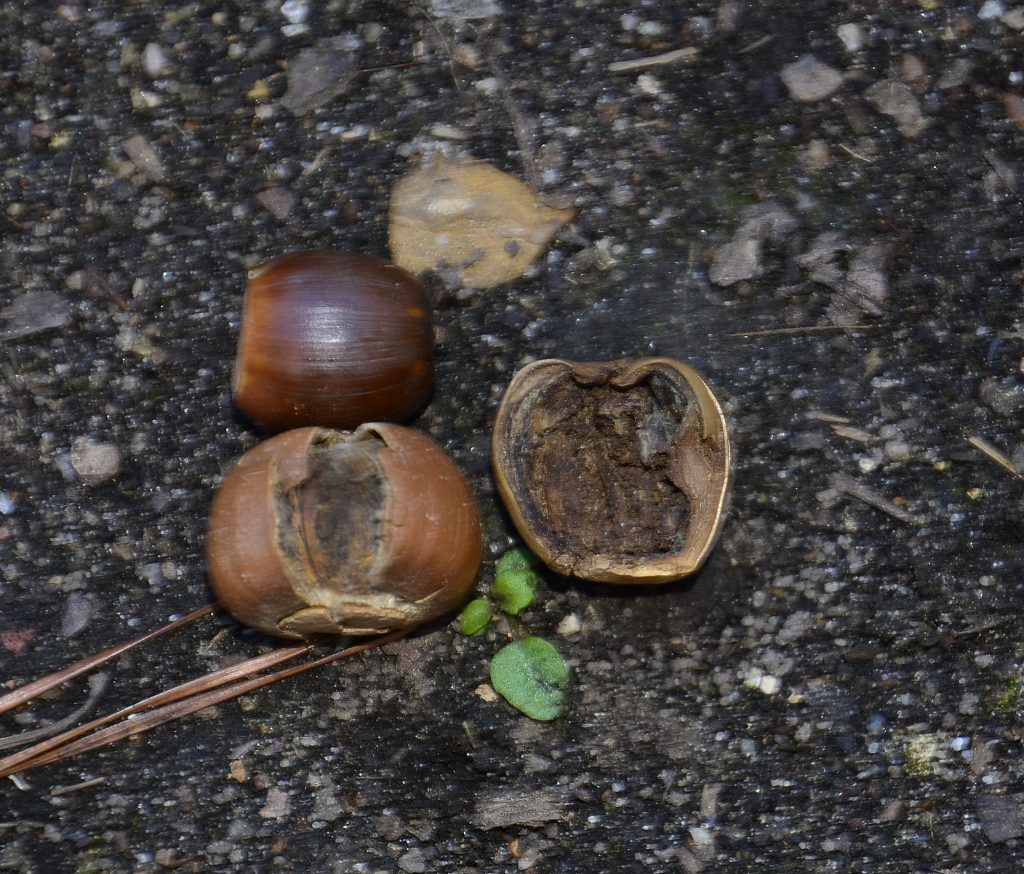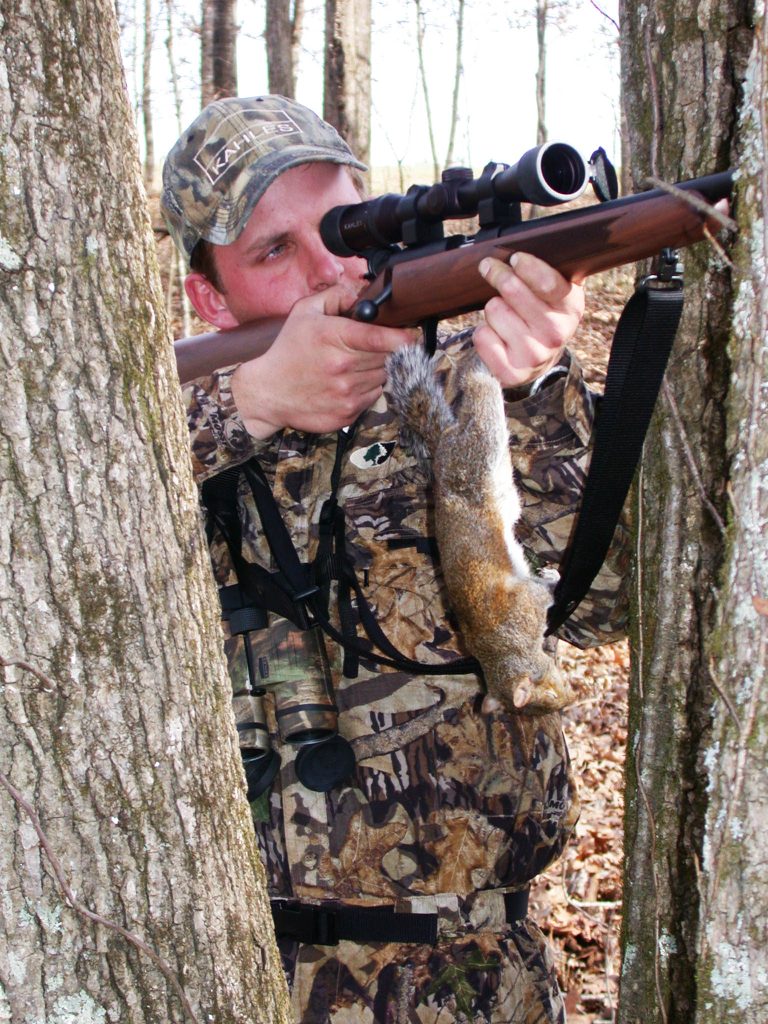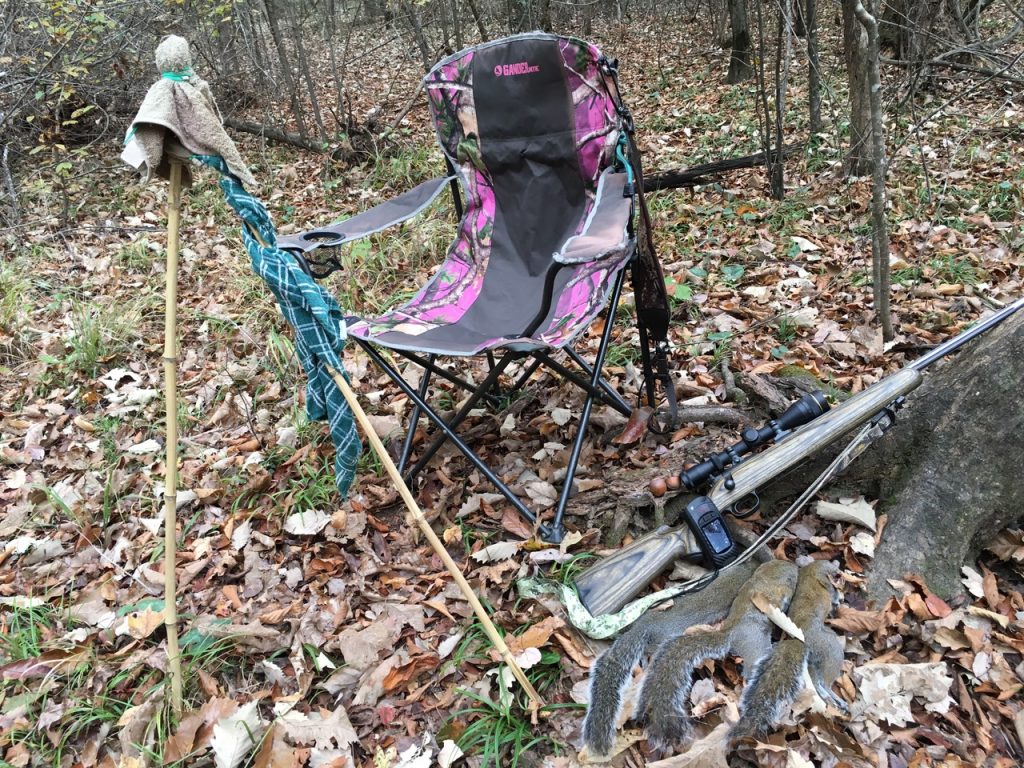“Squirrel hunting can teach you everything you need to know about hunting,” my friend Eddie Winks says, who’s taken the sport of squirrel hunting to an expert level. “You first need to know where to find squirrels. Squirrels prefer nuts of all kinds to eat, especially big ones like overcup and white oak acorns. Later in the season, squirrels enjoy red oak acorns as the larger ones are usually gone by then. Also, deer love acorns too, so, where you discover squirrels, you’ll locate deer.”
Before a squirrel hunt, Winks advised me to pinpoint squirrels’ locations where I found uneaten, partially-eaten or fully-eaten acorns. Then he told me his expert tactics for taking squirrels.
Eddie Winks’ Expert Squirrel Hunting Tactics
*Create a Path, Circle the Area, and Have Patience: Winks was one of the most-meticulous and successful squirrel hunters I ever knew. Once he found an area with squirrels, he’d use a yard rake to move the leaves away, exposing the ground. He’d create a path to work around and through where he’d located squirrels. Winks always made sure the path he’d cleared went past several large trees that he could hide behind.
With this strategy, he’d reach the first tree he wanted to hunt from and wait on daylight. He’d sit on a cushion to remain noiseless. He’d locate squirrels with barking and whining calls and the Mr. Squirrel Whistle. After he shot one or two squirrels, and the bushytails vanished, he’d move 30-50 yards to his next tree, making sure that the squirrels hadn’t spotted him. He’d then use a cutting call (a plastic screw with a plastic paddle) and pull the paddle down the plastic screw to make the sound of squirrels cutting acorns – calling softly and infrequently to make squirrels show themselves in the trees.
“You often can get two, and if you’re lucky, sometimes three squirrels, before they all scurry to their hiding places and seem to disappear,” Winks mentions. “The next step is patience, much like when you’re turkey or deer hunting. Most often, the squirrels will reappear in 10-20 minutes after you harvest the first few squirrels. Then, you can continue to take them, if the area’s heavily populated with bushytails. I’ll usually circle the entire area where I’ve seen the largest concentration of squirrels.”

*Stalk Slowly: Once Winks cleared a road of sticks and leaves, then he’d walk slowly – stalking like a leopard prowling for his prey. Dressed in camouflage from head to toe and using his 8×10 binoculars to scan the ground and tree tops in front of him, he’d plan his route to keep the squirrels he hoped to bag from seeing him as he approached.
*Know Your Rifle’s Bullet Drop: “Because you never know what distance you’ll be from bushytails, a critical factor in successful squirrel hunting is to know the bullet drop of your rifle at distances from 10-50 yards,” Winks explains. “A squirrel laying on a limb is a very-small target, so you must shoot accurately each time you squeeze the trigger.”
*Use Double Barking: Squirrels bark to let each other know where they are and to signify danger like predators or other critters moving on the ground. When squirrels bark, they give away their locations, making them easier for the hunter to find and take.

Double barking was a technique that Winks used often when hunting with friends. He’d place one friend 50-75 yards from him. If he was hunting with more than one friend, he’d have each hunter at roughly that same distance from him. One hunter would use a bellows-style squirrel call to bark like a bushytail. A few minutes later and/or immediately after the hunter barked, one of the other hunters would give the same call. Often, this technique would cause squirrels to come out from their hiding places and start barking back at the hunters. When this strategy was used in areas with an abundant squirrel population, each hunter would have an opportunity to bag squirrels.

*Know When to Use What Tactics: Most often, your best opportunity to take squirrels is when the leaves begin to fall. They’ll feel comfortable in the trees because the leaves provide some cover. One of the most-difficult yet fun times to take squirrels is when the leaves are off the trees, and squirrels can spot the hunter’s moving. So, don’t forget to stalk through the woods – especially early in the morning and late in the evening when the squirrels come out of their trees and are hunting acorns on the ground.
When the leaves are off the trees, and you’re hunting later in the season, hunting squirrels with a dog is much-more productive than stalk hunting or stand-hunting and is a much-easier and fun way to find and take them. A productive dog hunt usually starts later in the morning, an hour or two after daylight, or earlier in the afternoon when there are two to three hours of daylight left. At that time, squirrels generally will be out of the trees and feeding on the ground. A dog will pick up their scent, follow them to a tree and bark – telling the hunter which tree to look for the squirrel.
Winks considers dog hunting for squirrels the most enjoyable because he can train children how to squirrel hunt easily with dogs that will discover and bark to let hunters know the trees where the squirrels are.
Dr. Robert Sheppard’s Expert Squirrel Hunting Gear
Very-few squirrel hunters are as passionate about taking bushytails as Dr. Robert Sheppard of Tuscaloosa, Alabama. He’s as meticulous about finding about the very-best equipment he can choose for hunting squirrels, as he is practicing medicine.
*Guns: Today Dr. Sheppard hunts squirrels with four rifles: the Kimber .17 22 Long Rifle (LR) that’s necked-down to a .17 caliber bolt-action squirrel rifle; a Browning A Bolt in 17 HMR by Hornady Rimfire; a Kimber .22 Long Rifle (LR) Bolt Action; and a Browning T-Bolt .17 caliber.
Editor’s Note: Several of the rifles suggested by Dr.Sheppard are no longer sold new but are very good, reliable squirrel hunting rifles. If you can find them used, they are definitely worth picking up. Consider the Christensen Arms Ranger for a newer, more modern option. Also, take a look at our guide to choosing the best squirrel gun here.
“Over the years, I’ve bought about 50-different squirrel rifles because I love to squirrel hunt,” Sheppard explains. “I’ve continued to test squirrel rifles, until I’ve found the one that I feel is the most effective and accurate. My perfect squirrel rifle, for me, is the Kimber .17 caliber.”
Dr. Sheppard reports that Savage makes a much-less-expensive .17 caliber gun that’s about half as accurate as the Kimber Bolt, delivering a 1.5-inch group at 50 yards. The Kimber shoots a 0.25-inch group at 50 yards.

The .17 caliber rifle and bullet, even though smaller than a .22, is capable of downing almost any varmint from an armadillo and coyote size down to the size of a rat. Dr. Sheppard emphasizes, “Using a turrets’ style scope on my Kimber .17 that calculates my bullet’s performance at different distances means I don’t hesitate to shoot a squirrel out to 100 yards or a coyote out to 200 yards.”
*Ammunition: Dr. Sheppard prefers the .17 caliber ammunition over the .22 caliber when hunting squirrels. He reports that he’s killed several thousand squirrels with his Kimber .17. “If you’re serious about squirrel hunting and shoot .22 ammunition, you’ll see that the arc the bullet travels drops-off at about 40 yards. If you don’t know the distance you are from the squirrel, the tendency when shooting .22 ammo is to either shoot over or under the squirrel. A .22 rifle takes squirrels perfectly at 30 yards. However, at less than 30 yards, the bullet will drop or rise before it reaches the squirrel.”
Sheppard mentions that shooting squirrels after the leaves fall off the trees means you often must shoot them at a further distance than when the leaves are still on the trees. Sheppard explains he’s had to modify his squirrel hunting somewhat due to health issues. He now takes a folding chair to sit in when hunting squirrels and uses a two-legged shooting stick as his brace. When a squirrel comes out, and Sheppard can see it with his binoculars or hears the squirrel bark or squeal, he doesn’t have to hold over or under to make an accurate shot – even at a squirrel 100-yards away – by shooting .17 caliber cartridges.
Sheppard explains, “In 2007, Hornady created a .17 caliber cartridge with a muzzle velocity that moved 2000 feet per second – a .22 Magnum cartridge, necked-down to a .17 caliber. When I bought a rifle that shot .17 caliber bullets, I saw that it was much more accurate at longer ranges than a traditional .22 cartridge. The Hornady Magnum Rimfire (HMR) .17 caliber has almost the same velocity as a .308 Winchester. However, this much-smaller .17 caliber bullet travels faster and shoots flatter out to about 100 yards then a .22 traditional cartridge does. The .17 caliber is being pushed out of the rifle at 1.5 times the speed of sound. Therefore, the bullet hits the squirrel long before the sound of the bullet’s being fired reaches the squirrel. I don’t believe any cartridge made for a squirrel rifle is as fast and as noiseless as a .17 caliber.”

*Rifle Scopes: Sheppard prefers a Leupold scope. On his Browning A Bolt .17 caliber, he’s mounted a Leupold scope made with ballistic tabs built into the scope. This turret on top of the scope can be turned, and the scope will be automatically adjusted, so you can hold it on target out to 300 yards.
Final Thoughts
In the realm of squirrel hunting, mastery requires not only skill but also a deep understanding of the elusive creatures and the tools at hand. Eddie Winks and Dr. Robert Sheppard exemplify this expertise, each with their unique approaches and insights. From Winks’ meticulous tactics of creating paths and mastering the art of patience to Sheppard’s dedication to finding the perfect equipment, their combined wisdom forms a comprehensive guide for aspiring squirrel hunters. As leaves fall and seasons change, their knowledge stands as a testament to the intricate dance between hunter and prey, reminding us that in the pursuit of squirrels lies a wealth of lessons waiting to be learned amidst the rustling leaves and whispered barks of the forest.
Full Disclosure: This post may include affiliate links. There’s no extra charge to our readers for using these.




